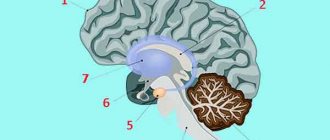Basic life cycles in the process of human development
Socialization as the process of a person’s adaptation to generally accepted social norms and rules of behavior covers all existing phases of human development as a biological and social being.
These developmental phases are also called the main life cycles of human development. There are four such cycles:
- The period of childhood - which includes the time period from birth to puberty, this cycle is characterized by the development of basic skills accepted in human society;
- The period of adolescence (from 14 to 20 years) - including preparation for the active working period of a person’s life;
- The period of maturity (from 18 to 60 years) is the most active period of a person’s life, characterized by the active development of all aspects of life.
- The period of old age (60 years and older) is a period of decreased human activity, characterized by exit from the active working period.
Help with student work on the topic Phases and content of the socialization process
Coursework 410 ₽ Essay 230 ₽ Test paper 230 ₽
Receive completed work or consultation with a specialist on your educational project Find out the cost
The essence of personality socialization
Krysko V.G. Social Psychology
PSYCHOLOGICAL SPECIFICITY OF PERSONAL SOCIALIZATION.
Basic concepts:
psychological features of personality socialization, factors of personality socialization, socio-psychological adaptation of personality, forms of personality socialization, mechanisms of personality socialization, stages of personality socialization
A person develops and improves under the influence of other people, adapts to fulfilling specific responsibilities in society, and bears a certain responsibility for his behavior, actions and deeds. This process is called socialization. It has its own characteristics.
The essence of personality socialization.
The concept of socialization. From the first days of his existence, a person is surrounded by other people. From the very beginning of his life he is involved in social interaction. A person acquires his first experience of communication even before he learns to speak. In the process of relationships with other people, he receives a certain social experience, which, being subjectively acquired, becomes an integral part of his personality.
Personal socialization is a two-way process of an individual’s assimilation of the social experience of the society to which he belongs, on the one hand, and the active reproduction and expansion by him of the systems of social connections and relationships in which he develops,
-
with another.
A person not only perceives social experience and masters it, but also actively transforms it into his own values, attitudes, positions, orientations, into his own vision of social relations. At the same time, the individual is subjectively included in various Social connections, in the performance of various role functions, thereby transforming both the social world around him and himself. Social experience includes many components, among which two main ones stand out:
a) norms, rules, values, relationships, etc. of the social environment;
b) culture of work, production and other activities.
In accordance with this, the formation and development of personality, as a process of an individual acquiring social experience and its expansion, multiplication, can be represented by two conditional stages.
The first consists in the formation and consolidation of the basic social and psychological values of a person: labor, moral, aesthetic, political, legal, environmental, family and everyday life, etc. This is the stage of general socialization
personality.
In addition, the process of mastering a particular profession or specialty by a person is also carried out. This is the stage of professional socialization
of the individual. The stages are interconnected and complement each other.
Socialization is not the antithesis of individualization. The process of socialization does not lead to the leveling of a person’s personality or individuality. Rather, on the contrary, in this process of socialization a person acquires his individuality, but most often in a complex and contradictory way.
The assimilation of social experience is always subjective. The same social situations are perceived and experienced differently by different individuals. And therefore they leave a different mark on the psyche, soul, and personality of different people. The social experience that different people gain from objectively identical social situations can, therefore, be significantly different. Thus, the assimilation of social experience, which underlies the process of socialization, also becomes a source of individualization of the individual, who not only subjectively assimilates this experience, but also actively processes it.
The individual acts as an active subject of socialization. Moreover, perhaps even the process of social adaptation of the individual should be considered as actively developing, and not just as actively adaptive. Socialization does not end when a person becomes an adult. It, figuratively speaking, is of the type of process “with an indefinite end,” although with a specific goal. And this process continues continuously throughout human ontogenesis. It follows from this that socialization is not only never completed, but also never complete.
A personality is socialized in the process of its adaptation to the environment and to social relationships. There are two types of adaptation: biophysiological and psychological. Biophysiological adaptation of personality
-
these are adaptations of the body to stable and changing environmental conditions (temperature, atmospheric pressure, humidity, lighting and other external physical conditions and influences), as well as to changes in itself.
A characteristic feature of human biological adaptation is that he can use a variety of aids that are products of his activity (for example, warm clothes, shelter, etc.). A person also exhibits the ability for voluntary mental regulation of certain biological processes and states, which expands his adaptive capabilities. Man is not a blank sheet of paper on which culture can write its text; he is a being charged with energy and structured in a certain way, a being who, adapting, reacts in a specific and established way to external conditions...
Human evolution is due to human adaptability and certain indestructible properties of human nature, which force him to never stop searching for conditions more suitable to his inner needs.
E. Fromm
Psychological adaptation is the process of bringing the inner world of an individual closer to the social and socio-psychological requirements of the environment, the conditions and content of people’s social life in the interests of fulfilling the corresponding social role functions. This is the harmonization of internal and external conditions of life and activity of the individual, the active development by man of the natural and social environments in all the diversity of their manifestations.
Since the end of the last century, the American scientist W. James and his followers (R. Lazarus, I. Hacker, L. Festinger, etc.), based on Darwin’s research, developed a functionalist approach to the theory of consciousness, believing that the main thing in it is identify the function of consciousness and its role in human survival. The main function of consciousness, in their opinion, is adaptation, consisting in the regulation of human interaction with the outside world. The role of consciousness, they believed, is to give the individual the opportunity to adapt to various situations that arise from morning to evening, from birth to death, either by repeating already developed forms of behavior, or by changing them depending on circumstances, or, finally , mastering new actions if the situation requires it. Representatives of this direction saw the origins of personality adaptation in the mismatch between the individual’s current level of preparedness, experience and the requirements of specific living conditions and activities.
Representatives of the psychoanalytic direction of Western psychology (3. Freud, E. Bern, A. Adler, R. Gardner, E. Erickson, etc.) considered the conflict that arises as a result of the discrepancy between a person’s needs, his motives, drives, and capabilities to be meaningful and normative as a source of personality adaptation. environmental requirements, social norms, rules that are limiting to a person.
Positivists (A. Bandura, A. Maslow, G. Allport, etc.) see the origins of personality adaptation in its conflict with the environment, the basis of which is social obstacles (and not only of a normative nature) that complicate the process of self-realization of the individual.
With the formation and approval in Soviet psychology of the theory of objective activity (A.N. Leontyev), the interpretation of human interaction with the environment in terms of adaptation increasingly gives way to its interpretation in terms of “appropriation” and “mastery” of the world of social objects.
The main difference between the processes of adaptation and appropriation is AN. Leontiev saw that “the process of biological adaptation is a process of changing the properties and abilities of an organism and its species behavior,” and the process of appropriation is a process “as a result of which the individual reproduces historically formed human abilities and functions”1.
Moreover, according to this theory, in the process of appropriation, not only “reproduction” occurs, but also development, an increase in human strength and capabilities. A.N. Leontyev, not without reason, argued that such a process does not exist in animals, just as the opposite process of objectifying their abilities in the objective products of their activity does not exist in them. In human adaptation, the leading side is human activity, which is not adaptive, but transformative and active in nature. Taking into account the patterns of industrial adaptation and considering it in a broad sense not only as the production of material goods, but also as the production of man as a social being, adaptation can be characterized as the active development of the natural as well as the social environment in all the diversity of its spheres —
economic, political, social and spiritual.
In the process of precisely this interaction with the environment, both its purposeful transformation and corresponding changes in the person himself, in his psyche, occur. As a result of these mutual changes, the degree of mismatch between the individual and the environment decreases. This is the fundamental solution to the question of adaptation in the domestic theory of activity.
Usually, there are two broad spheres of human life, and therefore of his psychological adaptation: social and environmental. The concepts of “social adaptation” and “ecological adaptation” reflect the substantive aspects of psychological adaptation.
One of the first developers of the theory of social adaptation was the Russian sociologist A.A. Bogdanov (1873-1928). He believed that social adaptation does not differ significantly from biological adaptation. At the same time, he quite strictly connected the consciousness of people with their professional activities and professional responsibilities.
Subsequently, problems of social adaptation were the subject of attention and were developed in the works of A.G. Zdravomyslova, V.N. Ivanova, G:A. Prudensky, G.V. Osipova, V.A. Yadov and others. The patterns of adaptation interaction have become a borderline area of research for representatives of many disciplines, scientific, theoretical and applied areas: sociology of the individual, sociology of the collective, sociology of professions, sociology of organizations, sociology of labor, labor problems of youth, career guidance and selection, management and socio-engineering activities, etc.
In the sociological literature, there are two approaches to considering the problems of social adaptation. First approach
defines social adaptation as the process of a person’s adaptation to a changing environment in all the variety of forms of its existence and manifestations through the inclusion of the individual in various connections and relationships with it, various types of activities.
The essence of the second
approach is that social and professional adaptation is considered in the context of interaction between the individual and the team, the individual and the contact social environment.
The conventionality of distinguishing these approaches is obvious. In real life, social adaptation is carried out both in a contact social environment and in a broad social environment through direct interaction of the individual with the environment. In this case, both the individual assimilates social norms, rules, values, relationships, etc., and his impact on the environment.
Thus, social adaptation is the entry into social-role connections and relationships, during which the individual masters social norms, rules, values, social experience, social relationships and actions.
Social adaptation of the individual is carried out in two areas:
- the socio-psychological sphere of life - the system of socio-psychological connections and attitudes of the individual that arise when he performs various socio-psychological roles. Therefore, a distinction is made between socio-psychological adaptation of the individual;
- the sphere of professional, educational, cognitive and other activity connections and relationships of the individual. Therefore, we also need to talk about her professional-activity social adaptation,
In this regard, it is customary to distinguish between primary and secondary socialization. It is believed that primary socialization
associated with the formation of a generalized image of reality.
The nature of secondary socialization is determined by the division of labor and the corresponding social distribution of knowledge. In other words, secondary socialization
represents the acquisition of role-specific knowledge when roles are directly or indirectly related to the division of labor (P. Berger, T. Luckman). There is also a slightly different view, in which socialization is considered as a process occurring in the following two directions: the formation of a person as an individual and the formation of a person as a subject of activity (B.G. Ananyev). The final effect of this socialization as a person and as a subject of activity is the formation of individuality.
Socio-psychological adaptation of a person is the process of acquiring a certain socio-psychological status, mastering certain socio-psychological role functions.
Status in social psychology is the position of an individual in the system of interpersonal relations, which determines the rights, responsibilities and privileges of a person.
In the process of socio-psychological adaptation, the individual strives to achieve harmony between the internal and external conditions of life and activity. As it is implemented, the adaptability of the individual increases. With full adaptation, the adequacy of a person’s mental activity to the given environmental conditions and his activities in certain circumstances is achieved.
Personality adaptability can be:
— internal,
manifested in the form of restructuring of the functional structures and systems of the individual during a certain transformation of the environment of her life and activity.
In this case, both external forms of behavior and the activity of the individual change and come into conformity with the expectations of the environment, with demands coming from outside. generalized adaptation of the personality
occurs - external
(behavioral, adaptive), when the personality does not internally restructure itself and retains its independence.
instrumental adaptation of the personality
takes place - mixed,
in which the personality is partially rebuilt and internally adjusted to the environment, its values, norms and at the same time partially adapts instrumentally, behaviorally, preserving both his “I” and his independence.
Socio-psychological adaptation is of two types:
1) progressive,
which is characterized by the achievement of all functions and goals of complete adaptation and during the implementation of which the unity of interests and goals of the individual, on the one hand, and groups, society as a whole, on the other, is achieved;
2) regressive,
which manifests itself as a formal adaptation that does not meet the interests of society, the development of a given social group and the individual himself.
Some psychologists designate regressive adaptation as conformal, based on the individual’s formal acceptance of social norms and requirements. In such a situation, a person deprives himself of the opportunity to self-realize, show his creative abilities, and experience self-esteem.
Only progressive adaptation can contribute to the true socialization of the individual, while long-term adherence to a conformist strategy forms the individual’s tendency to systematic errors of behavior (violations of norms, expectations, patterns of behavior) and leads to the creation of ever new problematic situations, for adaptation to which he has no adaptive abilities , nor ready-made mechanisms and their complexes. According to the mechanism of implementation, socio-psychological adaptation can be voluntary or forced.
E. Fromm believed that a person can adapt to undesirable, negative social phenomena, for example, slavery, fascism, dictatorship. But this adaptation will take place to the detriment of the person - due to the deformation of the intellectual and moral qualities of the individual, the development of mental and emotional disorders in him, which, in the end, will lead to a change in the environment, since a person is not able to change his nature. E. Fromm quite clearly expressed the idea of the permanent adaptation process in humans and, in fact, the positivity of personality maladaptation as a source of its development. The inadaptability of the individual thus becomes, according to E. Fromm, inevitable in conditions that do not correspond to its existence. These thoughts were confirmed in the research of A.V. Petrovsky and V.A. Petrovsky.
Polar adaptation and essentially destructive is
the process
of maladjustment
of a personality, when the development of its intrapsychic processes and behavior does not lead to the resolution of problematic situations in its life and activities, but to the aggravation and intensification of the difficulties of the personality and the unpleasant experiences that they cause.
Disadaptation can be pathological and non-pathological. Pathological maladjustment leads to irreversible transformation of mental and physiological functions, behavior, to a permanent conflict of the individual with the environment and with himself, and even to suicide. In one case, a personal conflict is the “last straw” and aggravates maladjustment, transferring it from the pre-dispositional phase to the suicidal phase; in another case, the conflict itself gives rise to a process of maladaptation, the semantic content of which is distinguished by rejection of a subjectively intolerable situation.
Factors of personality maladjustment are varied. Usually there are two groups of them:
a) environmental;
b) intrapsychic,
associated with the characteristics of the human psyche, primarily with accentuated traits of his character.
Among the signs of maladjustment, objective and subjective ones are distinguished. Towards objective
signs include changes in human behavior in the social sphere, inconsistency with one’s social functions, pathological transformation of behavior;
to subjective -
psychological and emotional shifts from negatively colored experiences to clinically pronounced psychopathological syndromes.
Subjective symptoms include a state of psychological “dead end” that arises as a result of a person’s long stay in a conflict (external or internal) and
the absence of the necessary adaptive mechanisms to get out of this state.
There are usually several types of personality maladjustment:
• persistent situational maladjustment,
characterized by a person’s lack of adaptation mechanisms, the presence of desire, but the inability to adapt. This most often happens to people who are in a group but isolated from it. The consequence of this phenomenon may be a defensive complex, leading to an illusory perception of one’s place in the group;
• temporary maladjustment,
in which there is an imbalance between the individual and the environment, giving rise to the adaptive activity of the individual;
• general stable maladjustment,
which is a state of permanent frustration that activates pathological defense mechanisms.
Along with the term “adaptation”, the term “readaptation” is also used.
understood as a process of restructuring a personality with radical changes in the conditions and content of its life and activities: from peacetime to wartime, single life to family life, etc. If it is impossible to re-adapt a personality, it becomes maladjusted.
Adaptation and re-adaptation differ only in the degree of personality restructuring. The adaptation process is associated with correction, completion, deformation, partial restructuring of individual functional systems of the psyche or the personality as a whole. Re-adaptation occurs where the values, semantic formations of the individual, its goals and norms, the need-motivational sphere as a whole are rebuilt (or need to be restructured) into opposite ones in content, methods and means of implementation, or change to a significant extent.
During re-adaptation, a person may need readaptation if there is a transition to the previous conditions of his life and activity. So, for example, the transition of a person from civilian, peaceful conditions of his life to military ones is usually accompanied not only by adaptation, but also by re-adaptation of his psyche. When returning to civilian life, such military personnel undergo readaptation, often with serious psychological consequences.
Socio-psychological adaptation also acts as a means of protecting the individual, with the help of which internal mental tension, anxiety, and destabilizing states that arise in a person when interacting with other people and society as a whole are weakened and eliminated.
The protective mechanisms of the psyche act as ways of psychological adaptation of a person. The decisive significance in their formation and manifestation, as research shows, belongs to traumatic events in the sphere of interpersonal relationships and especially in early childhood. In general, when a person masters the mechanisms of psychological defense, this increases his adaptive potential and contributes to the success of socio-psychological adaptation.
Socio-psychological adaptation thus performs the function of protecting the individual. Its other functions include:
• achieving optimal balance in the dynamic system “personality - social environment”;
• maximum manifestation and development of the individual’s creative potential and abilities, increasing his social activity;
• regulation of communication and relationships;
• formation of emotionally comfortable positions of the individual;
• self-realization of the individual;
• self-knowledge and self-correction;
• increasing the efficiency of activities, both of the adapting individual and the social environment and team;
• increasing stability and cohesion of the social environment;
• maintaining mental health.
Socialization and psychological adaptation are close, interdependent, interdependent processes, but not identical. Socialization of personality is the process of formation and development of personality through mastering social experience. Psychological adaptation is one of the leading and determining mechanisms of personality socialization.
However, not every adaptation process leads to the socialization of the individual, for example, his conformist behavior. At the same time, complete, internal psychological adaptation of an individual may turn out to be identical to the process of its socialization.
Another mechanism for the socialization of the individual is education - a controlled and purposeful process of socialization, during which socially approved norms and rules of behavior, moral and moral values, and relationships existing in society are fixed in the mind of the individual.
Factors of personality socialization. In the most general form, the factors of personality socialization can be presented in the form of two large groups: first
includes social factors that reflect the socio-cultural aspect of socialization and affects the problems of its group, historical, cultural and ethnic specificity, the
second -
individual personal factors, largely determined by the uniqueness of the individual’s life path.
Social factors usually include macro-, meso- and microfactors that reflect socio-political, economic, historical, national, etc. features of personal development, including quality of life, environmental conditions, the occurrence of extreme and other social circumstances.
Macro factors are social and natural determinants of socialization and personal development, conditioned by its living as part of large social communities.
Country, state
(in the common sense, synonyms) are concepts adopted to distinguish people living within certain territorial and administrative boundaries and united among themselves due to historical, socio-economic, political and psychological reasons. The specifics of the development of a country or state determine the most important features of the socialization of the population, especially young people.
Culture -
a system of spiritual forms of ensuring the life activity and socialization of people. It covers all aspects of human life - biological (food, sleep, rest, sexual intercourse, natural needs for something), production (creation of means of material life support - tools, food, clothing, housing), spiritual (language and speech activity , worldview, aesthetic activity, etc.), social (communication, social relations).
Mesofactors are determinants of the socialization of an individual, conditioned by his living in communities of average size.
Ethnicity (nation)
- a historically established stable collection of people in a certain territory, possessing a single language, common relatively stable characteristics of culture and psyche, as well as a common self-awareness (awareness of its unity and difference from all other similar entities), recorded in its self-name. Belonging to a particular nation and its traditions largely determines the specifics of a person’s socialization.
Regional conditions -
conditions characteristic of the socialization of people living in one or another part of the country, state, which has its own distinctive characteristics (a single socio-economic system, a common historical past, cultural and social identity).
Type of settlement
- a village, town, city, region, for certain reasons, giving originality to the socialization of the people living in them.
Mass Communications
— technical means (print, radio, cinematography, television), with the help of which information (knowledge, spiritual values, moral and legal norms, etc.) is disseminated to quantitatively large audiences.
Microfactors —
these are determinants of personal socialization related to the upbringing and training of people in small groups (family, work collective, religious organization or educational institution).
Of particular importance in the socialization of an individual is the historical development of the state, community, and groups of people to which he belongs. Each period and stage of development of human society places certain demands on the individual. Famous Russian historian A.Ya. Gurevich, a specialist in the Middle Ages, argued that “not originality, not difference from others, but, on the contrary, the most active inclusion in a group, a corporation, in the divinely established order - such was the social valor required of an individual” in the Middle Ages. A person of that era could only fully gain and realize himself within the framework of a collective.
Similar features of socialization in the Middle Ages in Rus' were noted by other researchers. And only with the development of capitalism did the destruction of a person’s integration into a social group, class, and the predominance of the individual-personal level of aspirations begin.
It was also noted that during stable periods of social development, people with a predominant orientation towards group values turned out to be more socially adapted to the surrounding reality, while at turning points of crisis in history different personality types became more active: on the one hand, those in whom universal human values at the same time predominate. , and individual and personal claims; and on the other hand, people fleeing social storms with the help of habitual stereotypes of orientation toward group norms inherent in a stable stage of social development. In conditions of a social crisis, the dominance of the last of these types of personalities leads to a search for “external” enemies, a preference for “one’s own” (national, professional, age, territorial, etc.) group.
Individual factors of socialization of the individual are no less significant. From the point of view of psychology, socialization cannot be considered as a simple mechanical reflection by the individual of directly experienced or observed social experience. The assimilation of this experience is subjective. The same social situations are perceived differently and experienced differently by different individuals. Therefore, different individuals can derive different social experiences from objectively identical social situations.
Much depends on the conditions under which specific individuals develop and undergo socialization. In stable periods of social development, according to a study by the American scientist L. Kohlberg, children under 7 years of age are mostly at the pre-conventional level of moral development. Their behavior is determined mainly by the desire to avoid punishment or receive encouragement, i.e., according to all data, an immature individual level of aspirations dominates in them. By the age of 13 and before finishing school, the majority of children have a predominant group level of identity, when the reality of an action is assessed depending on the point of view of the child’s reference group. Apparently, this level of identity remains dominant during stable periods of social development, since only 10% of children over 16 years of age achieve a post-conventional level of moral development, which corresponds to the simultaneous expression of individual-personal and universal characteristics of personality orientation.
The process of socialization proceeds differently at different stages of ontogenesis in conditions of social crisis. A social crisis is characterized, as a rule, by a disruption of the normal life and activities of society, the weakening of its previous value system, and a state of anomie, that is, the alienation of people from each other. Three age groups find themselves in a fundamentally different situation
:
1) children up to adolescence inclusive;
2) boys and young adults;
3) middle-aged and elderly people.
In addition, some of the most developed people do not accept imposed views, but form their own value system, different from the accepted one.
This does not mean that the vast majority of middle-aged and older people are absolutely immune to fundamental social changes. However, their socialization takes place: 1) either through the experience of a deep personal crisis; 2) either quite easily, if during stable periods of social development such a person was among social outsiders (or did not fully realize his potential), and in crisis conditions his abilities were in demand.
Contents of personality socialization.
Forms of personality socialization. A person cannot immediately, from the moment of birth, assimilate all social experience.
Socialization is a long process, extended in time and space.
The socialization of children differs from the socialization of adults and especially older people. Moreover, it is individual in nature and is associated with certain cycles in the field of physical, anatomical-physiological, sensory, emotional, cognitive and social development of the individual.
A tradition has developed according to which it is customary to distinguish in the structure of socialization:
1) content (from this point of view they talk about socialization and asocialization as an adaptation to negative experience);
2) breadth, i.e. the number of areas in which a person was able to adapt.
As a rule, first of all, the content of socialization is considered, which is not a direct result of what a person sees and hears. A person can see one thing, hear another, say a third, think a fourth. The content of socialization is determined, on the one hand, by the totality of social influences (political programs and doctrines, the media, culture), and on the other hand, by the individual’s attitude to all this. Moreover, these relationships depend not only on the characteristics of the individual himself, but also on the social situation in which he finds himself: material conditions or, say, considerations related to his career. A person can only outwardly demonstrate obedience to the law, loyalty to political and legal institutions, knowing that double standards exist in the field of politics, and that one will have to “pay” for deviating from the rules of the game, the prescribed norms. In other words, the content of socialization cannot be judged only by verbal behavior.
The true meaning of socialization lies in the actualization of the “I”, the disclosure of the potential of the individual, his capabilities, and creative nature. However, this is only possible in a real democracy. In a totalitarian state, everything is completely different. From the point of view of E. Fromm, under these conditions such methods of socialization as masochism, sadism, destruction and conformism are observed.
Masochism is the desire for submission, the renunciation of the “I”, its merging with someone or something, in other words, it is an escape from loneliness and freedom.
Socialization in the form of sadism is carried out by:
1) placing other people in a position dependent on oneself and acquiring unlimited power over them;
2) exploitation of others;
3) intimidation of others.
Destruction as a method of socialization consists in ridding a person of his own powerlessness through the destruction of the surrounding world Conformism
in its extreme expression means the abandonment of one’s own “I” and the transformation of a person into a robot, the replacement of a true personality with a pseudo-personality.
Main stages of socialization
According to these life cycles, there are four main stages of socialization:
1. Primary socialization, which corresponds to the stage of socialization of infancy; 1.Secondary socialization, coinciding with education; 1. Socialization of maturity is the stage at which the individual turns into an independent and independent person, is capable of economic independence and is ready to start a family. 1. Socialization of old age is the stage at which the individual’s activity gradually decreases and he has the right to count on the help and support of the state and his own children.
Note 1
All these stages are associated with the individual acquiring a new social status, mastering and living new roles. The duration of each of these stages and its content depend on the characterological characteristics of the individual and the level of development of the society in which he lives.
Need advice from a teacher in this subject area? Ask a question to the teacher and get an answer in 15 minutes! Ask a Question
Types of socialization
Since socialization is a very complex and multifaceted process, it is customary to view it through the prism of the main directions (types).
Sex-role socialization. Its meaning lies in the fact that, as a person grows up, he consistently masters different roles. For example, boy-boy-man or girl-girl-woman.
Family and household socialization - in accordance with gender and status in the family, an individual acts as a mother, wife, husband, father, daughter, grandmother, sister or brother.
Professional and labor – socialization in accordance with the chosen profession (doctor, teacher, military man), as well as in accordance with the position held (boss, subordinate).
Subcultural-group - socialization in accordance with the informal or public association a person joins. For example, biker, punk, rocker and more.
Types of socialization also differ depending on the period in which the individual assumes a particular role.
— — Do you need help creating a study plan? — Specify a topic and receive a response in 15 minutes — — — — — — get help — —
- Complete socialization of the individual - the individual fully and completely complies with the requirements of the social group that it puts forward. He also effectively performs his functions without prejudice to his own interests;
- Incomplete (partial) socialization of an individual - the correspondence of skills and abilities to the chosen social group, but the presence of contradictions with internal attitudes;
- One-sided socialization of an individual - a person receives a full amount of knowledge and skills, and also develops his skills, but only in one area of his life. For example, success only in career, or only in family life;
- Resocialization - an individual gains new knowledge, re-forms his values and attitudes, while completely rejecting everything old.








